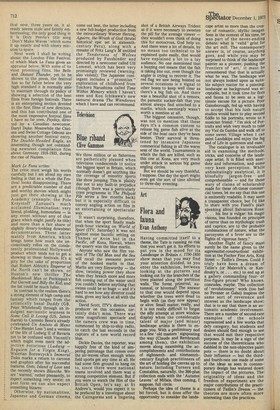Television
Blue riband
Clive Gammon
We three million or so fishermen are pathetically pleased when television condescends to notice the biggest sport in Britain, which normally doesn't get anything like the coverage of minority sports like show jumping. This is plainly due not to any built-in prejudice (though there was a particularly crass programme in The Philpott File series a few months back) but it is especially difficult to convey angling action on film in an entertaining or spectacular way.
It wasn't surprising, therefore, that when the sport finally made peak-hour viewing on World of Sport (ITV, Saturday) it was not against some bucolic setting on Thames or Avon but in the Pacific, off Kona, Hawaii, where the quarry was the blue marlin.
Anyone who saw the film version of The Old Man and the Sea will recall the awesome power of the hooked marlin in that. Marlin are very filmworthy — the slow, twisting power they show when they breach more and more fish coming out of the water until you couldn't believe anything that swims could be so huge — and it's hard to see how any director could miss, given any luck at all with the action.
David Scott, ITV's director and producer on this occasion, certainly didn't miss. There was some magnificent spectacle andl the camera crew was in time, summoned by ship-to-ship radio,, to catch the last seconds in the capture of a new world record! blue.
Dickie Davies, the reporter, was! happily free of the kind of simpering patronage that comes over the air-waves often enough when: field sports get any time at all. He had some firm ground to hang on to, since there were national teams involved and there was a strong competitive element. But if you were to watch the film of the British Open, let's say, at St Andrew's, would you expect it to be prefaced by a travelogue about the Cairngorms and a lingering shot of a British Airways Trident as if it were necessary to sweeten the pill for the average viewer — they wouldn't even think of doing this for motocross, God help us. And there were a lot of details, by no means too technical to be explained quite easily, that would have explained a lot to a lay audience. No one mentioned that a buzzing reel means that the fish is taking line out, even though the angler is trying to recover it. The red flag we saw being hoisted on several occasions is a signal to other boats to keep well clear as there's a big fish on. And there was a beautiful shot of a remora, the parasitic sucker-fish that you almost always find attached to a marlin, which seemingly wasn't worth a mention at all.
The biggest omission, though, was not to mention that these days it's a common custom to release big game fish alive at the side of the boat once they've been beaten. Their survival is threatened by intensive Japanese commerical fishing in all the warm seas of the world. Tournaments in which the fish are killed, such as this one at Kona, are very much under attack in serious big game angling circles.
But we should be very thankful, I suppose. One day the sport might even get the sort of time allotted to three-day eventing.










































 Previous page
Previous page